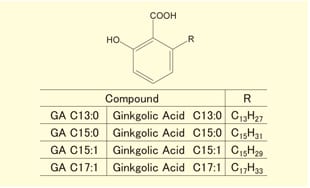Analysis of Ginkgolic Acid in Ginkgo Biloba Leaf Extract

Fig. 1 Structural Formula of Ginkgolic Acids
Ginkgo biloba leaf extract contains the active ingredients from ginkgo biloba leaves, which are reported to be effective against poor blood circulation in the brain and peripheral blood vessels. It is used as a health supplement in the USA and Japan, and as a prescription medication in Germany and France. As ginkgo biloba leaves contain alkylphenols, including ginkgolic acids, that may cause allergic reactions, the United States Pharmacopeia (USP) prescribes an upper limit for the ginkgolic acid content of ginkgo biloba extract.
An example of the analysis of ginkgolic acids in ginkgo biloba leaf extract is introduced below.
Ginkgolic acid C13:0 (GA C13:0), GA C15:0, GA C15:1, and GA C17:1 were analyzed in ginkgo biloba leaf extract.
Fig. 1 shows the structural formula of these ginkgolic acids.
Due to the high hydrophobicity of the ginkgolic acids, a Shim-pack CLC-C8 separation column containing silica gel modified with an octyl group (C8) was used. A photodiode array detector was used for the analysis. Table 1 shows the analytical conditions.
Fig. 2 shows the chromatogram for a standard solution of four ginkgolic acid components measured by gradient elution at a 311 nm wavelength (UV).


Fig. 2 Chromatogram of Four Ginkgolic Acids
The analyzed sample was a commercial supplement containing ginkgo biloba leaf extract. Fig. 3 shows the pretreatment procedure. As virtually no ginkgolic acids were detected in this supplement, the pretreatment solution was spiked with a ginkgolic acid standard solution. Fig. 4 shows the chromatogram obtained.

Fig. 3 Sample Pretreatment Procedure

Fig. 4 Chromatograms of Supplement Containing Ginkgo Biloba Leaf Extract
(Upper: Spiked with ginkgolic acids, Lower: Not spiked)


